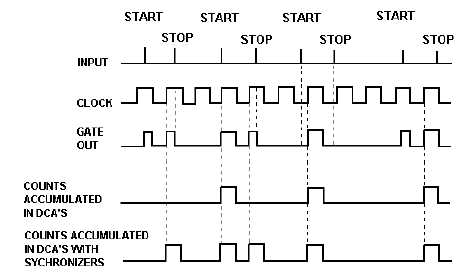5-19
Time Interval Averaging
The time interval averaging technique is based on the fact that if the 1 count error is truly random,
it can be reduced by averaging a number of measurements. The words "truly random" are significant. For
time interval averaging to work, the time interval must (1) be repetitive and (2) have a repetition
frequency that is asynchronous to the instrument's clock. Under these conditions, the resolution of the
measurement is:
With averaging, resolution of a time interval measurement is limited only by the noise inherent in the
instrument. The 5328A can obtain 10-picoseconds resolution. Most time interval averaging has one
severe limitation: The clock period limits the minimum measurable time interval. With the FUNCTION
selector switch in the T.I. AVG AB position, synchronizers are used to remove this limitation. These
synchronizers enable the 5328A to measure intervals as short as 100 picoseconds.
Referring to figure 5-16, note that the input waveshape shows a repetitive time interval, which is
asynchronous to the square wave clock. When these signals are applied to the main gate, with no
synchronizers, an output similar to the third waveform results. Since the DCAs are designed to count at
the clock frequency and are unable to accept pulses of shorter duration than the clock, the resulting counts
accumulated in the DCAs will be in error, as shown in the fourth waveform. This problem is alleviated by
the synchronizers, which are designed to detect leading edges of the clock pulses that occur while the gate
is open. They detect and reconstruct the leading edges, making the pulses applied to the DCAs the same
duration as the clock, as shown in the fifth waveform. Occasionally, when the input time interval
repetition is synchronous with the internal clock, time interval averaging cannot be performed.
Figure 5-16.—Synchronizer operation with time interval averaging.
This ends our discussion on electronic frequency counters. Now, we'll study an area of electronics
test equipment that is becoming more widespread and important each day—the testing of electronic logic



